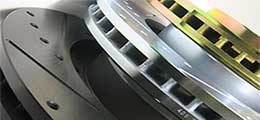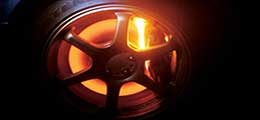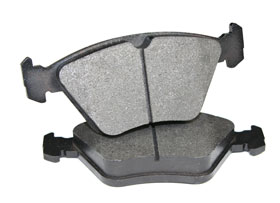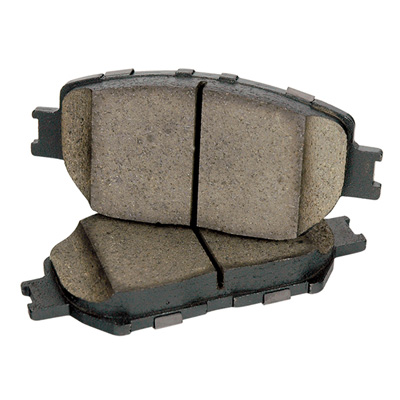There is a lot of press from ceramic brake pad manufacturers and distributors claiming ceramic materials are superior in comparison to semi-metallic formulations.
It is true that nearly 30% of new auto manufacturers are equipping their vehicles with ceramic brake pads now, but this should not warrant a brake pad swap in every situation. There are some benefits to using ceramic brake pads as well as semi-metallic brake pads, but drawbacks exist in every situation.
To understand the differences between the two types of brake pads, you must first understand how they are constructed. Ceramic brake pads are generally composed of dense ceramic material and embedded copper fibers. Semi-metallic brake pads, on the other hand, are made from synthetic resins and embedded metal fibers (generally steel).
BRAKE DUST COMPARISON
Ceramic brake pad sellers usually boast their ceramic pads produce less brake dust than a semi-metallic pad. It's true that ceramics produce less dust per given time unit and it's a result of the friction mechanism that is being used: ceramic brake pads use adherent friction (think adhesive or sticky) and semi-metallic brake pads use abrasive friction (think sand paper on wood).
BRAKE PAD DURABILITY AND COST COMPARISON
A ceramic pad usually costs a bit more upfront compared to its semi-metallic counterpart, but requires less frequent brake pad changes. You may deduce that ceramic brake pads cost less overall in terms of total pads that may need to be purchased over time, but this is not entirely true.
What gives this calculation a false reality is that if you select a brake pad that does not perform within the temperature range you need it to, be it a ceramic brake pad or semi-metallic brake pad, you run the risk of running into issues prematurely.
Ceramic brake pads aren't meant to perform well in higher temperature ranges compared to their semi-metallic counterparts. In aggressive applications, ceramic brake pads run the risk of fading or overheating. When this happens uneven deposits of the friction material will transfer to the rotor. The uneven deposits will then create pulsation issues that people are all too familiar with.
On the other end of the spectrum, if you use a high-performance pad (usually an abrasive pad of semi-metallic compound) and do not use the brake pads at the temperature range it was intended, you will also run into this problem. So, knowing which combination of rotors and pads are appropriate for your use and for your application is highly important.
For starters, go with a brake pad compound that is designed for your car (what the manufacturer recommends). You will want to make adjustments with which combination of rotors and pads to use depending on your driving style and application.
BRAKE NOISE COMPARISON
You will also hear from ceramic brake pad sellers that by adding ceramic brakes to your vehicle, brake noise will be reduced. This is possible because the pad material vibrates at frequencies outside of what the normal human ear can hear as opposed to semi-metallic. But while this may be true, brake pad noise can be a result of a number of reasons.
PERFORMANCE DIFFERENCES
Ceramic brake pads can perform well in a wide temperature range that is ideal for day-to-day traffic. For sport or heavier sized sedans, trucks and fleet vehciles, a semi-metallic brake pad is suggested. Semi-metallic brake pads or further abrasive pads are more favorable for high performance.
Click here to shop some ceramic options and here for semi-metallic options.









